BMW R 18 Motorcycle Test by Adam ‘Chad’ Child
Considering this is a standard production bike, it’s stunning. It looks like it’s just rolled out of a museum. Adam head to Germany to discover it performs as well as it looks.
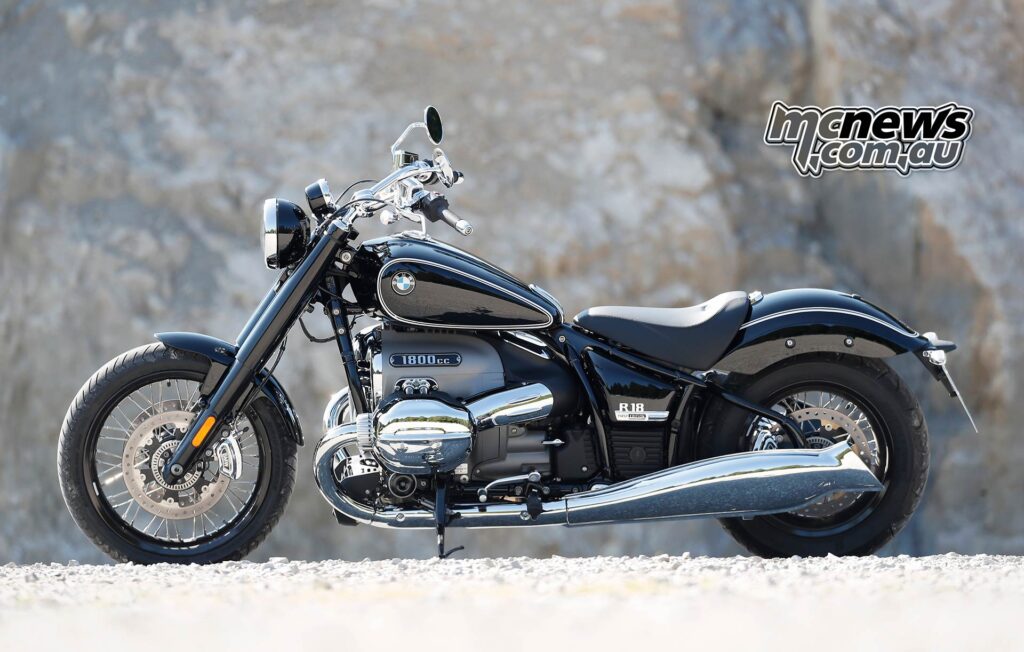
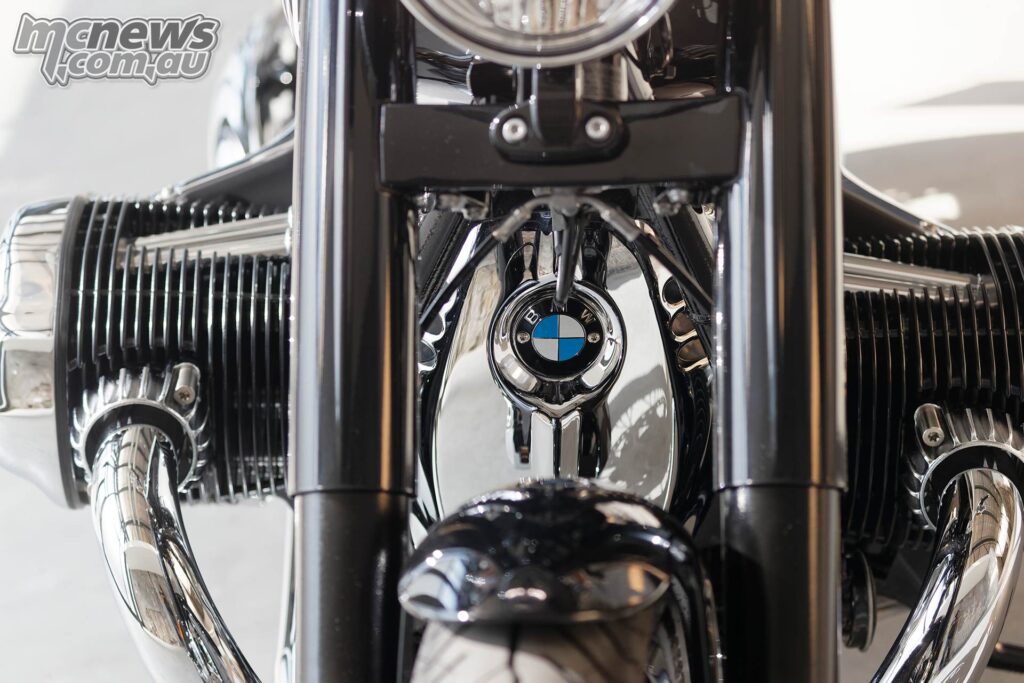
The R 18’s engine starts with a charismatic rock, and if you have never ridden an opposed twin before, it may take you by surprise. Each blip of the throttle pushes the bike to the left. I celebrate this quirkiness. At tick-over, around 900rpm, displayed on a digital clock, the ’bar-ends dance around while the instruments vibrate slightly. This only adds to its appeal. It has character, something not all BMWs are gifted with.
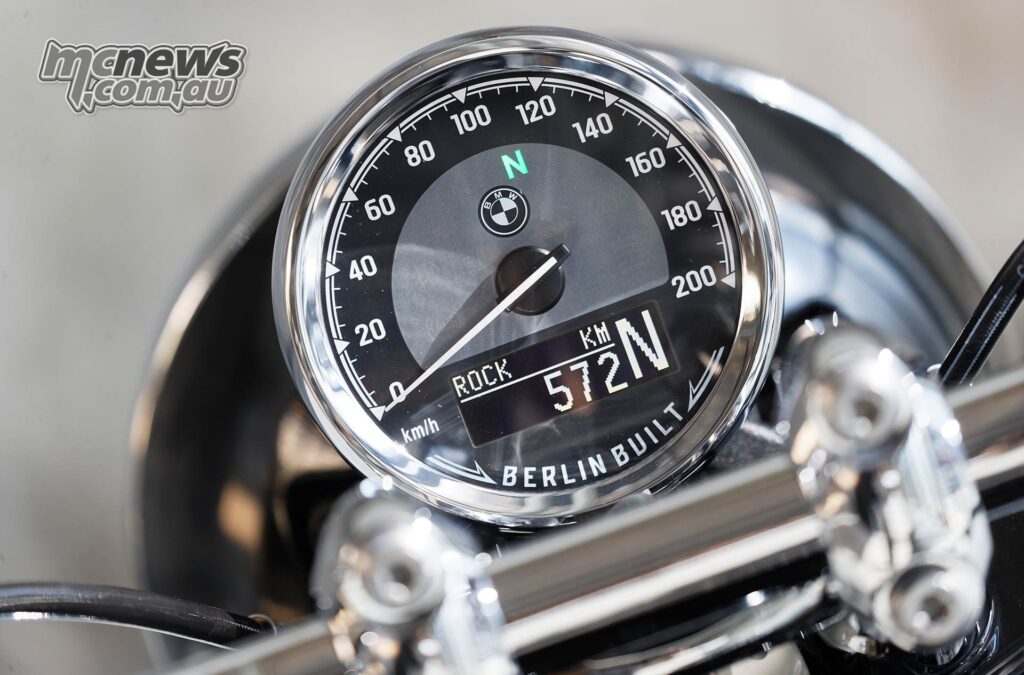
It’s a striking bike in the flesh; a work of art clearly inspired by BMW’s early boxer machines from the ’20s and ’30s, like the R 32 and R 5. Elements of it are almost Art Deco, like the R 7 prototype from 1934. It doesn’t scream at you like a modern sportsbike, it’s not covered in lavish chrome like a Harley, and it doesn’t need neon lights and music like a Honda Goldwing. The R 18 is unique and clearly a BMW. Remove the badge, and you’d still know it was a BMW. Uneducated admirers could even mistakenly think it was a true classic.
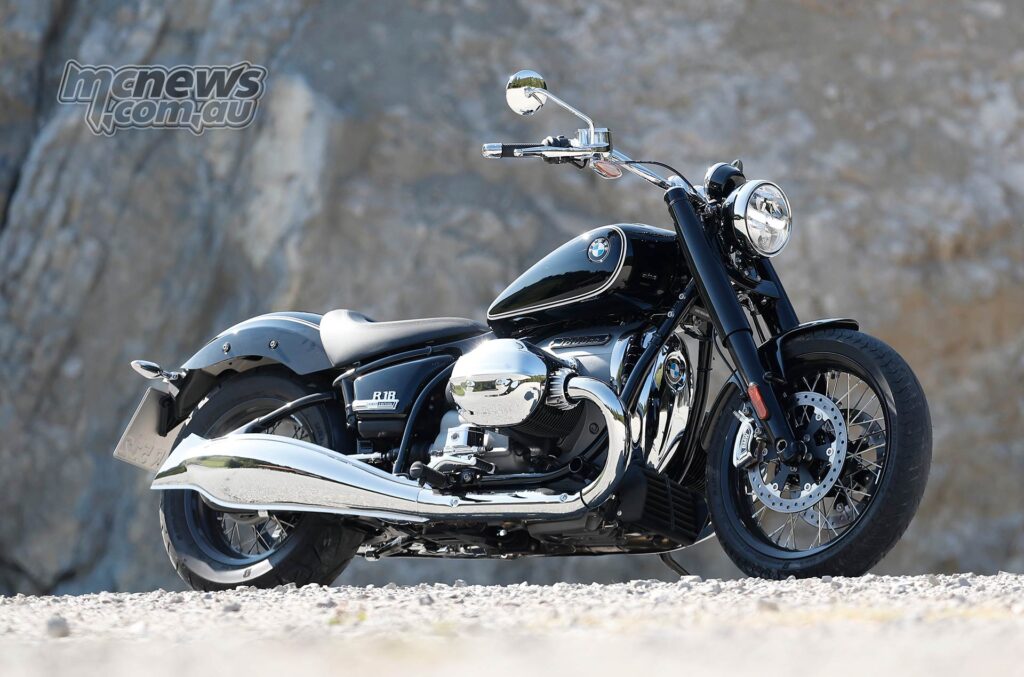
Like the original R 5, the R 18’s now-modern frame blends into the swing-arm to give the sense it’s a traditional hardtail.
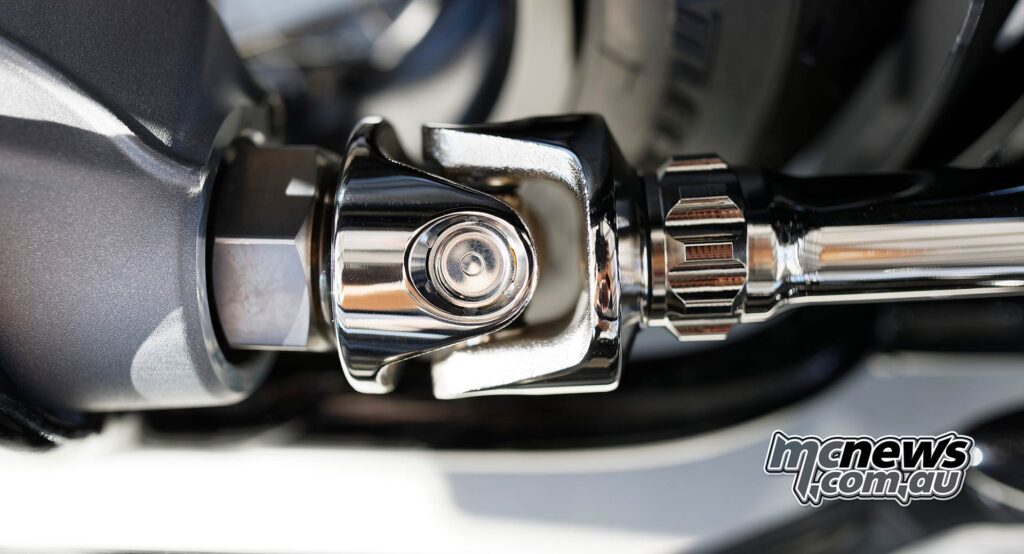
The fishtail exhausts mirror the R 5’s from 1936, and the exposed nickel-plated shaft-drive is lovely.
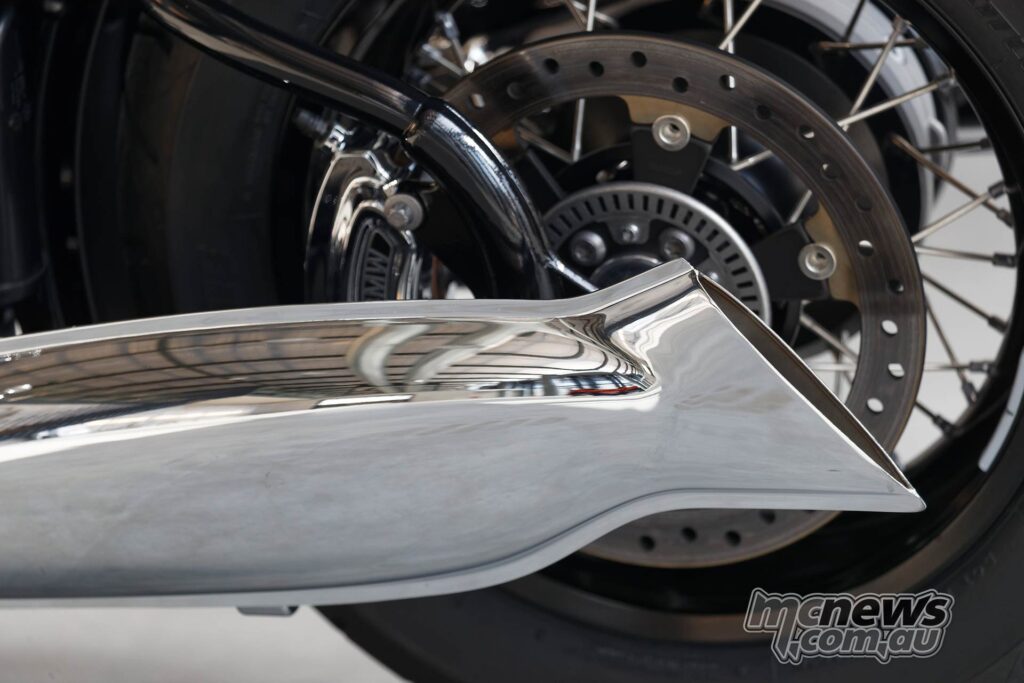
Even the little manual chrome lever which activates a reverse gear is neatly tucked away (it’s an optional extra). The centrally-mounted clocks have ‘Berlin Built’ inscribed on the dials, and the double pinstriping appears to be entirely hand-painted. Everywhere you look, the R 18 looks like a one-off special, and not a mass-produced bike just wheeled off the production line.
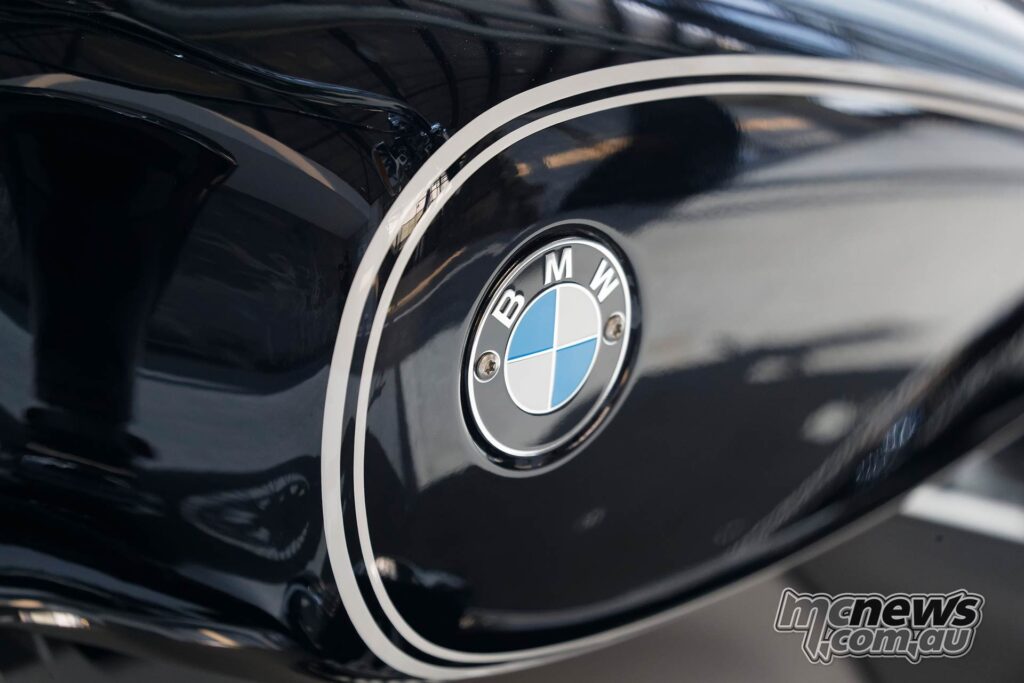 It is a wonderful paradox. It looks classical, yet has up-to-date clocks, LED lights, modern suspension, and rider aids, like ABS and traction control. Obviously the gigantic air-cooled 1802cc boxer is the lynch-pin which holds the design together and gives the R 18 its distinctive image and unmistakeable genetics. I actually can’t remember the last time an engine took centre stage on a motorcycle.
It is a wonderful paradox. It looks classical, yet has up-to-date clocks, LED lights, modern suspension, and rider aids, like ABS and traction control. Obviously the gigantic air-cooled 1802cc boxer is the lynch-pin which holds the design together and gives the R 18 its distinctive image and unmistakeable genetics. I actually can’t remember the last time an engine took centre stage on a motorcycle.
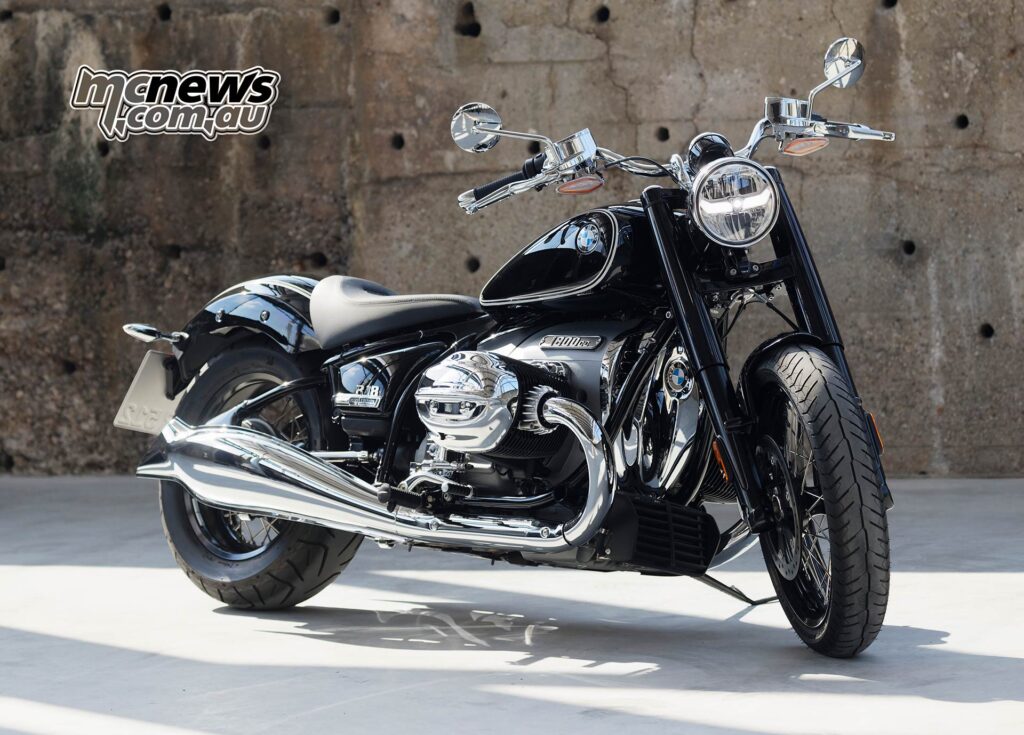
You just cannot hide that colossal boxer engine. Each cylinder has a 107.1mm bore, with pistons as large as my hand. The engine, including the gearbox and intake system, weighs 110.8 kg. That’s like a big, beefy bloke hung in the frame. And it’s an 1802cc air-cooled engine, so peak power and torque are way down in the rev range.
Peak horsepower is 91 hp at just 4750 rpm, and the huge 116.5 ft-lb (157.9 Nm) of torque is at 3000 rpm. So it’s barely ticking over. The last time an engine created this much torque it was powering tank-tracks. This is the most powerful boxer engine ever used in a motorcycle, and even between 2000-3000 rpm it is producing more than 110 ft-lb (149 Nm) of torque.
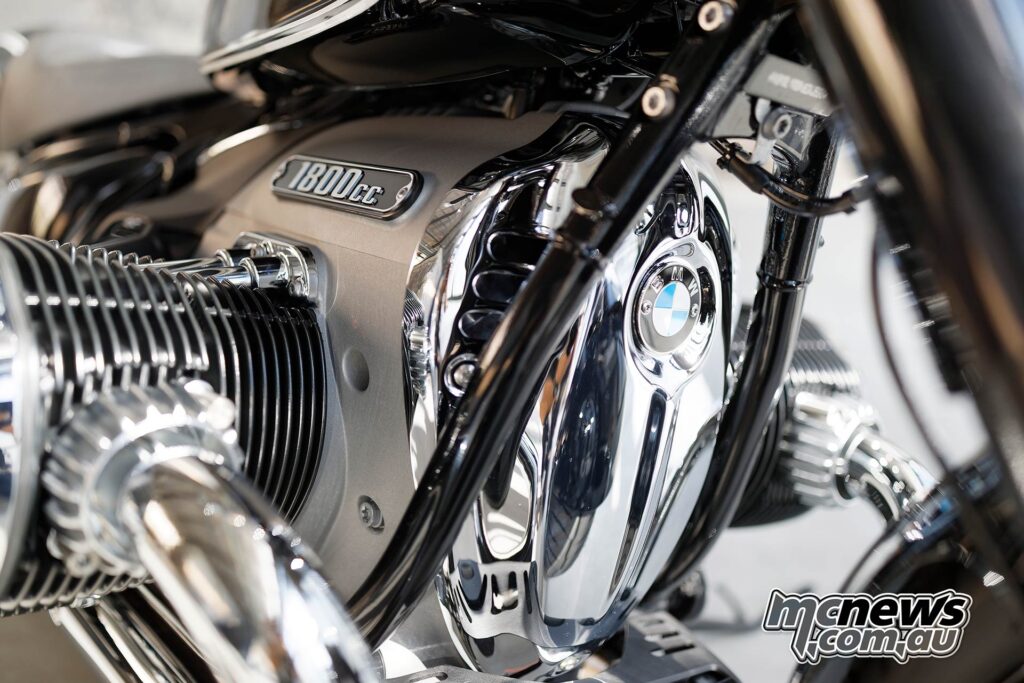
But as impressive as the torque and power are, they are still considerably less than Triumph’s Rocket III, and it’s down on horses compared to Ducati’s Diavel.
When you throw a leg over the relatively low seat and sit down, you’re immediately captivated by the engine, like a cheery drunk to his favourite happy hour. Each protruding cylinder head is almost visually overwhelming, and it’s rather strange to see so much engine while seated on the bike.
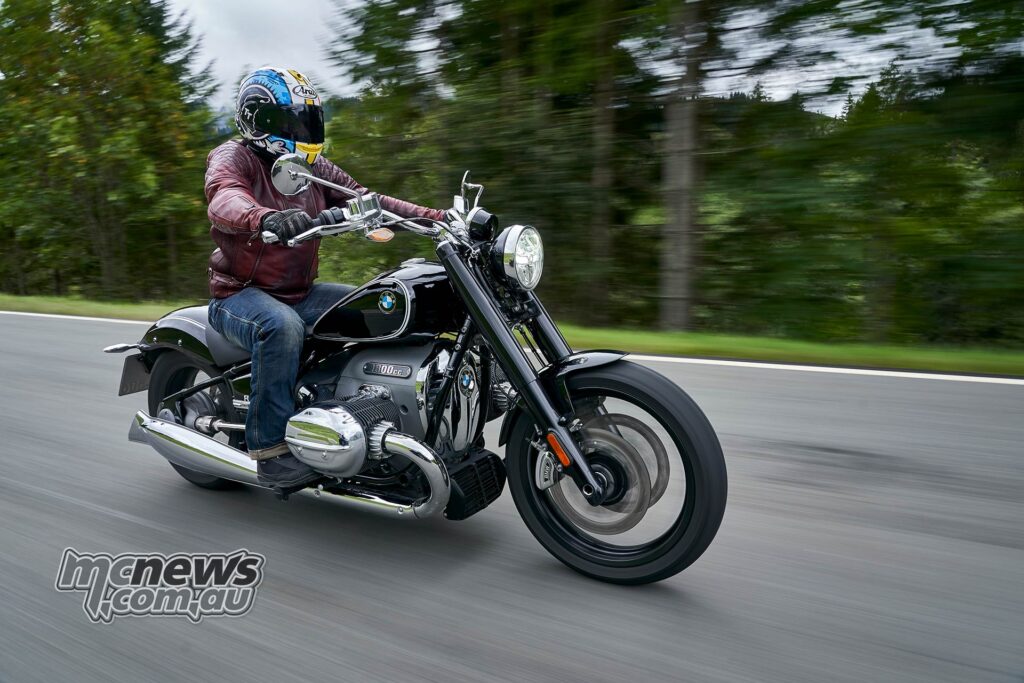
It’s also a tad lop-sided. The right cylinder is set closer to the rider because it sits further back on the crank, which runs down the centreline of the bike. When your feet are on the mid-way pegs, your shins are close to the huge cylinders, and you can feel their heat in traffic.
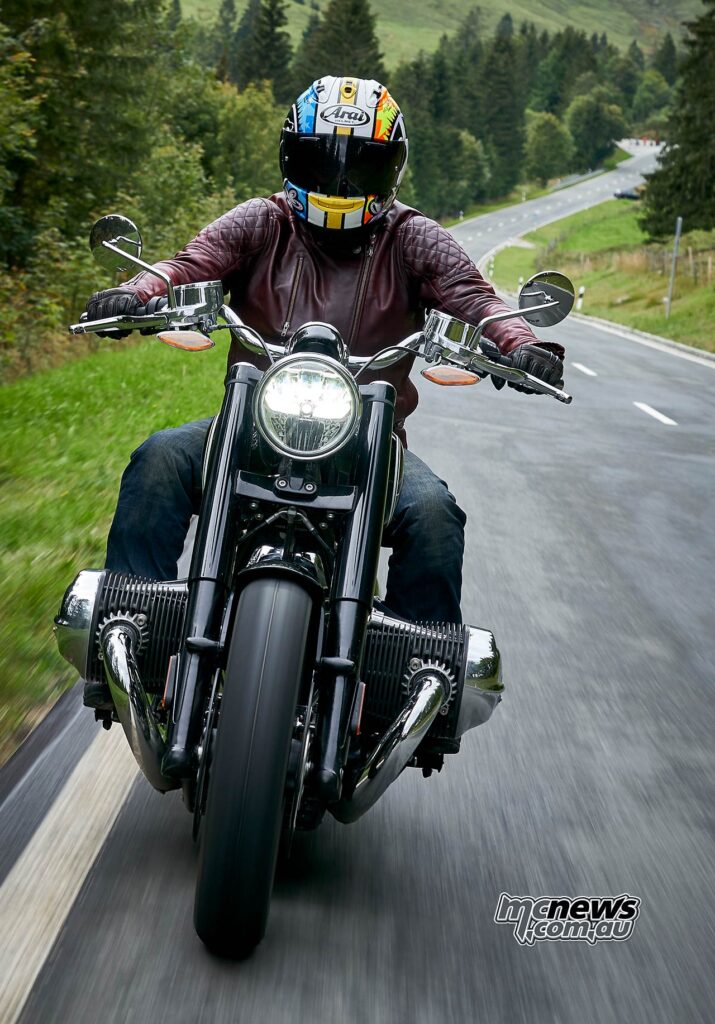
This was a blessing in Germany. The pots dried out my wet boots and jeans after a downpour. At one stop, I discovered the cylinders are also large enough to rest a coffee on. They even dry your gloves remarkably well.
It will be interesting to see how much heat is generated in the middle of summer when you’re stuck in traffic. Your right foot, covering the back brake, is almost directly underneath the cylinder. It’s not annoying, just quirky, which only adds to the appeal of the R 18.
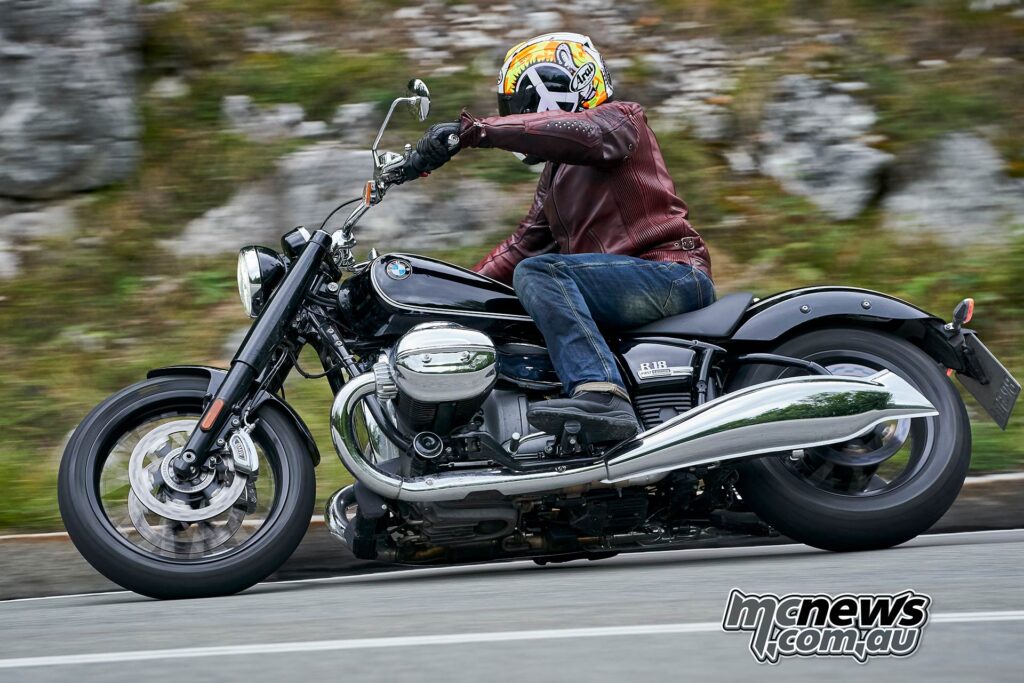 It’s a shame the fish-tail twin-exhausts don’t sound as good as they look. There is a little bark when you start up the big motor, but after that, it’s all a little muted. I know BMW must conform to Euro 5, and on large throttle openings there is a rumble. But from such a large, charismatic engine I was hoping for a little more.
It’s a shame the fish-tail twin-exhausts don’t sound as good as they look. There is a little bark when you start up the big motor, but after that, it’s all a little muted. I know BMW must conform to Euro 5, and on large throttle openings there is a rumble. But from such a large, charismatic engine I was hoping for a little more.
I don’t want it to be annoying, like an American V-twin with straight pipes which starts car alarms, but just something would be nice. Maybe the odd pop on overrun. It’s like watching football on the TV during Covid. There’s just no noise or atmosphere.
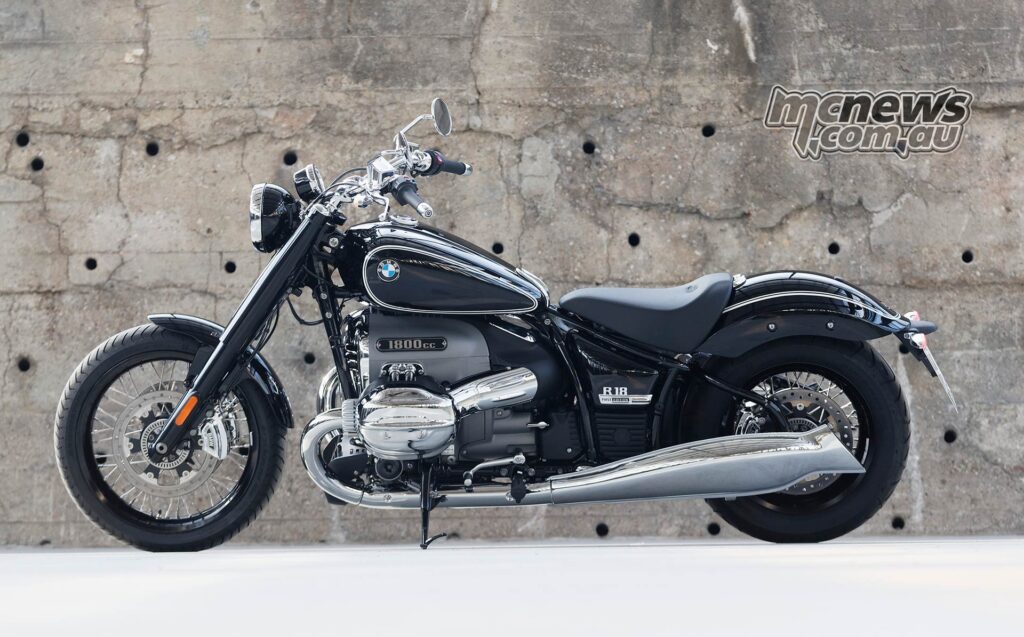
The power is effortless, the fuelling is excellent, and you can really feel the disparity in the power modes, Rain, Roll, and Rock – no, I’m not joking. That’s what the modes have been named.
As you’d expect, all the work is low in the rev range; just tickle the throttle for progressive acceleration. You don’t really need to pass 3000 rpm.
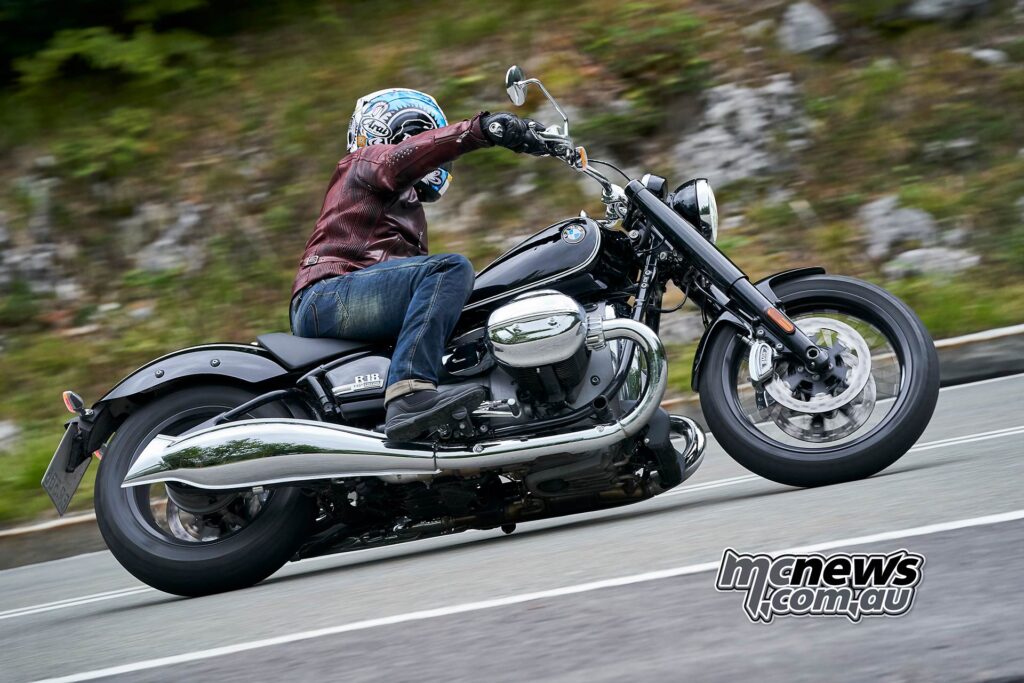
Peak power is at 4750 rpm, but then it tails off to find a soft rev limiter just after 5500 rpm. It does get a little vibey in the last quarter of the rev range, noticeably above 4000 rpm, but if you’re revving it that hard, you’re not really riding the big boxer how it was designed to be ridden.
The best way is to simply short shift and ride the torque. The gearbox is smooth, but for me it feels like it needed a heel-and-toe gearshift and footboards (which are optional), rather than the standard pegs and gear lever.
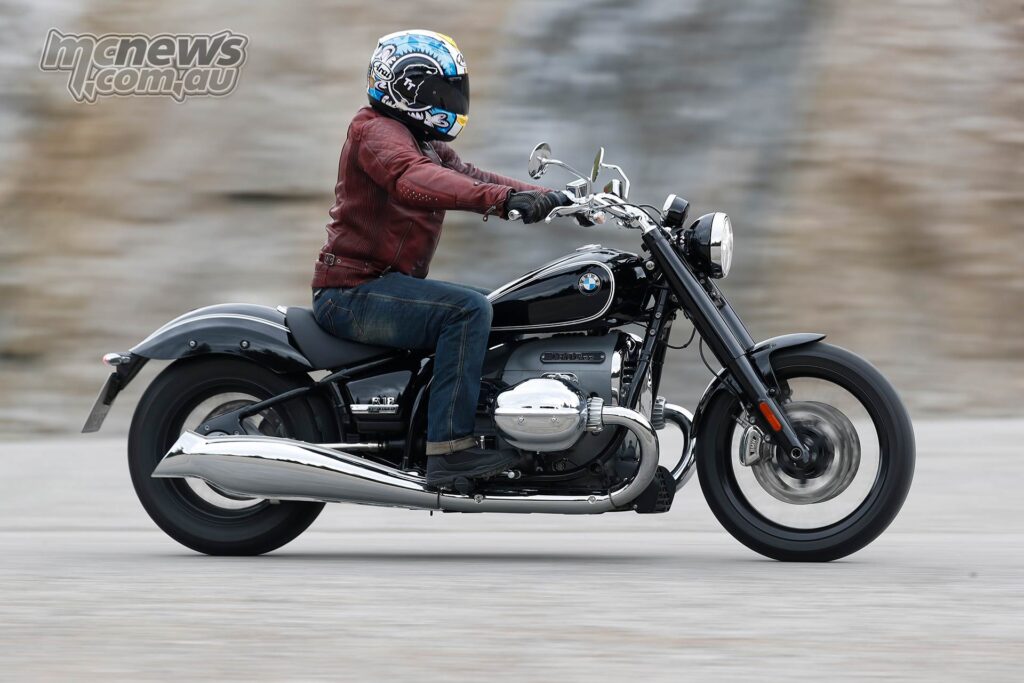
The revs noticeably drop when you change from fifth to sixth gear. It will gladly pull from just over 1200 rpm in top but usually, at town speed, I was back to fifth. Sixth gear is noticeably tall, which is perfect for cruising.
On the motorway at 100 km/h, the big girl is plodding along at 2200 rpm. At 120 km/h, revs increase a little to 2500 rpm, and it’s really effortless and smooth. Once you push on a little to 140 km/h and above, it’s revving closer to 3000 rpm and the vibrations are more noticeable. And it’s a shame the R 18 doesn’t have cruise-control as standard, which is what I’d expect from this type of bike.
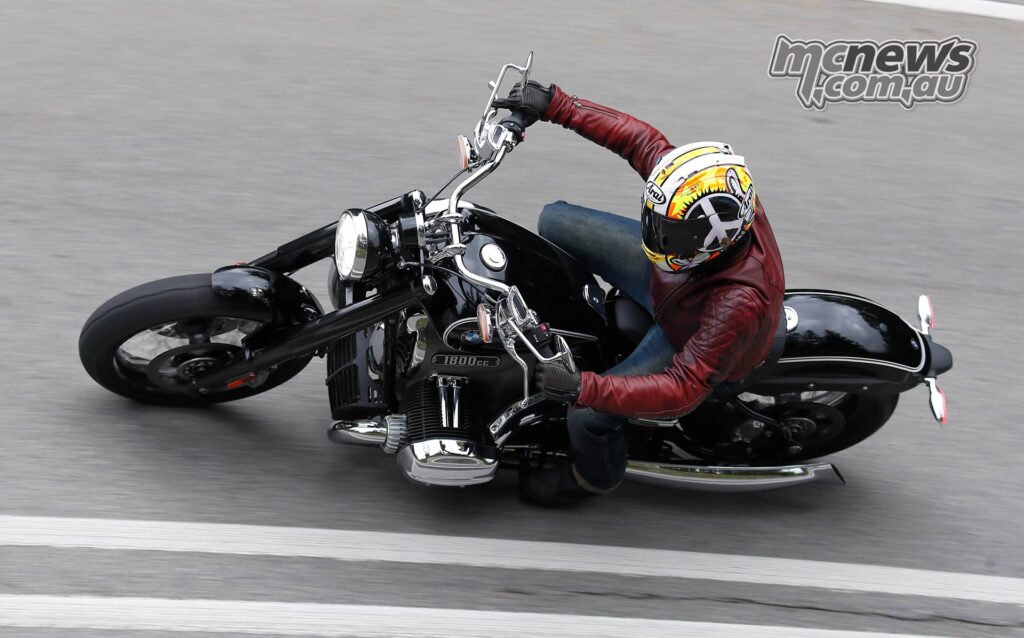
Each cylinder is a vast lump of metal, with the aerodynamic coefficient of a London bus. And let’s not forget about the weight, so it should be horrendous on fuel. But since it revs so slowly, like a tug boat, it’s actually not that bad with BMW claiming just over 21 km/litre. On our 280km-long ride, a mixture of motorways and mountain passes south of Munich, I managed 23 km/litre. In theory, you can expect over 320 km before needing to fill up, though in fact it’s closer to 210-220 km before the fuel light starts to shine.
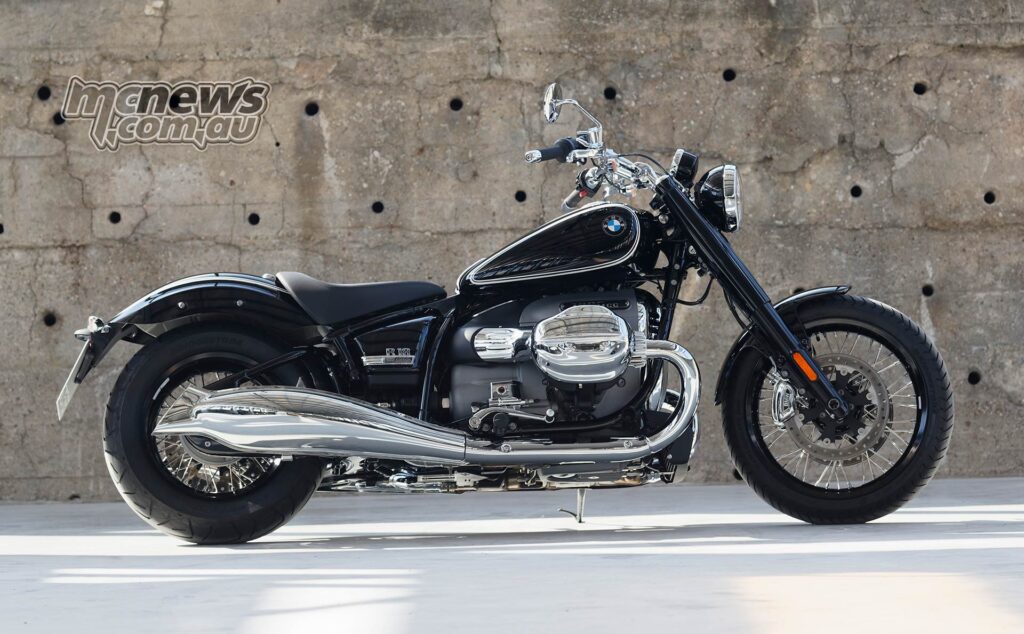
Personally, especially on a cruiser, I favour a fuel gauge or range indicator so I know how much fuel is remaining on each journey. I much prefer to start planning for a re-fuel, rather than panicking when the light comes on. Plus, I dislike getting fully kitted up and ready, and starting the ride, only to see the fuel light after a few kilometres. And while I’m having a gripe, the ignition is keyless, but the fuel cap and steering lock are not, so you still have to carry a key, which totally defeats the object of having a keyless ignition.
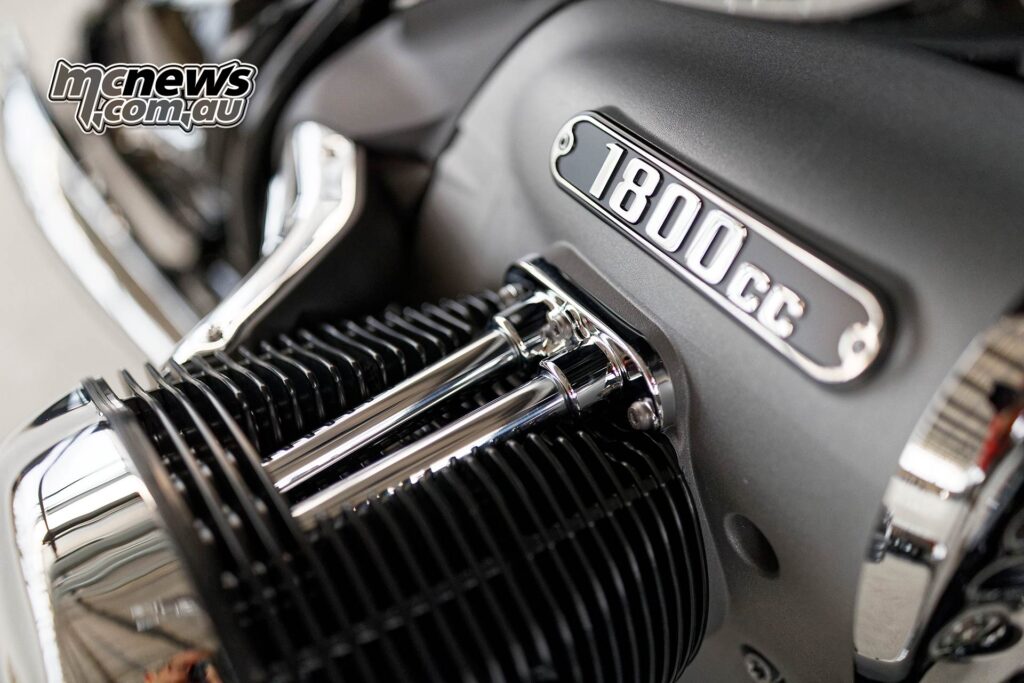
There is no getting away from the fact this is a 345 kg bike. A fully-dressed Goldwing is 381 kg; add the rider and we’re easily over 400 kg on the R 18. That is what cows weigh. Some bikes hide their weight once they’re moving, and the BMW does this, feeling far lighter than it is. But those huge protruding cylinders and the rocking motion between gear changes are a constant reminder of the bike’s size.
You’re always aware you’re on a large bike. The weight is low, but unlike an American V-twin, you can actually see the engine and think about that weight before attempting a roundabout at speed. On every ride, you always have the bike’s weight in the back of your mind.
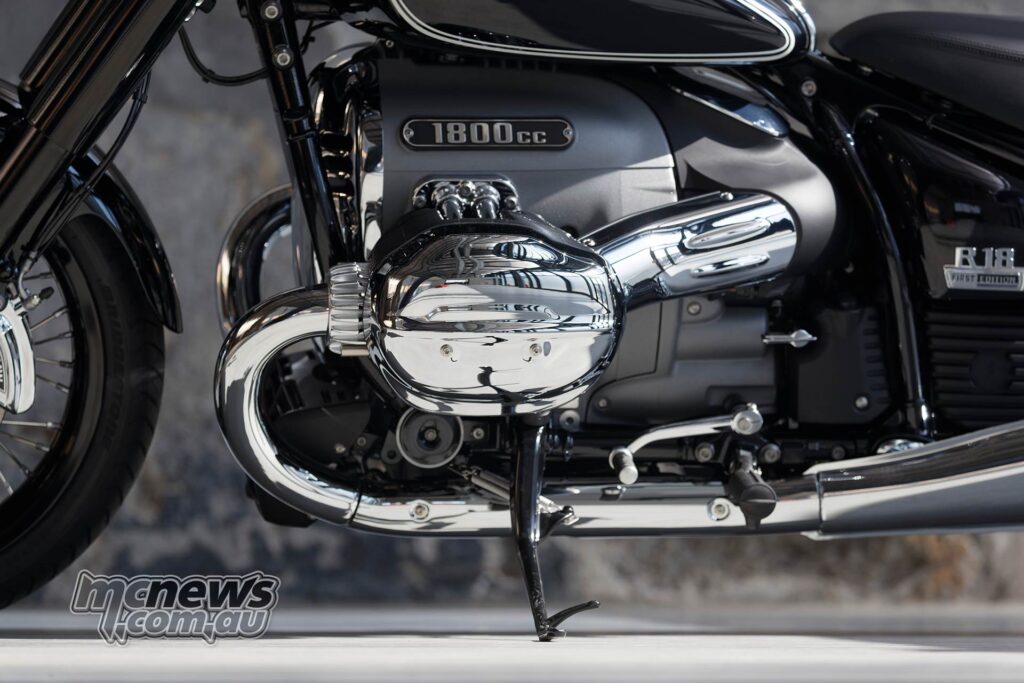
The relatively basic set-up is impressive. The forks don’t dive or buckle, the shock and ride are impressive – it feels like the font is communicating with the rear and vice-versa. Some big cruisers feel like the front was designed by one team and the rear by another, or they thought about the looks and chrome, but left the handling for Friday afternoon drinks in the pub. The BMW designers never went to the pub until it was finished. This is a bike clearly designed from the ground up.
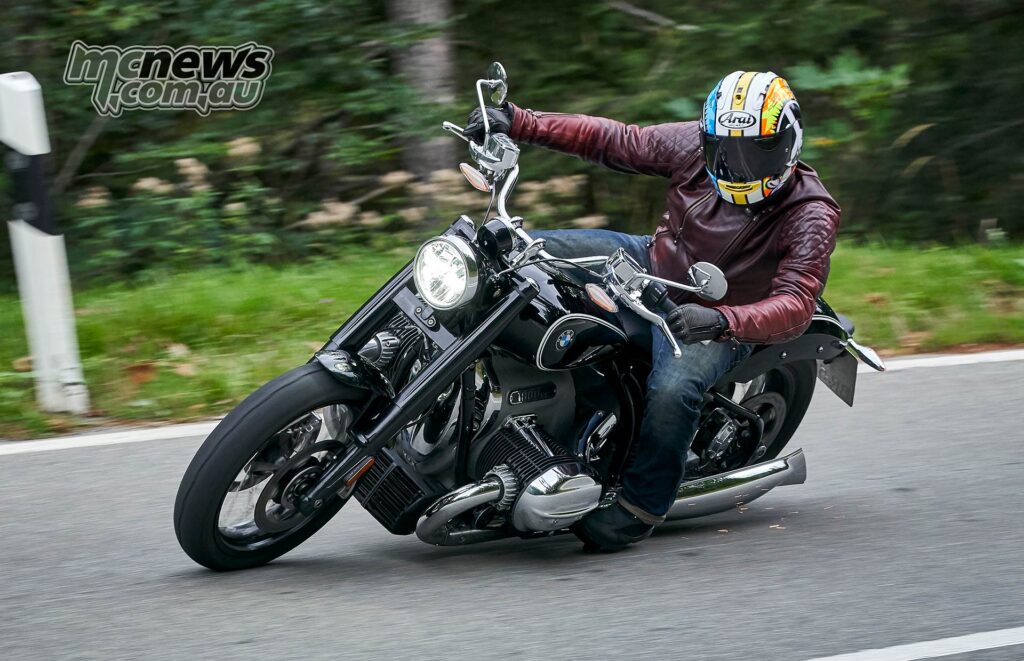
Rather than steer into corners, it rolls in. You roll the bike over its large front wheel and onto its side. It’s easy to deck the pegs, which are hinged and not fixed. But even when the pegs throw a rooster-tail of sparks it doesn’t feel like the BMW is on the limit and wanting to head straight on.
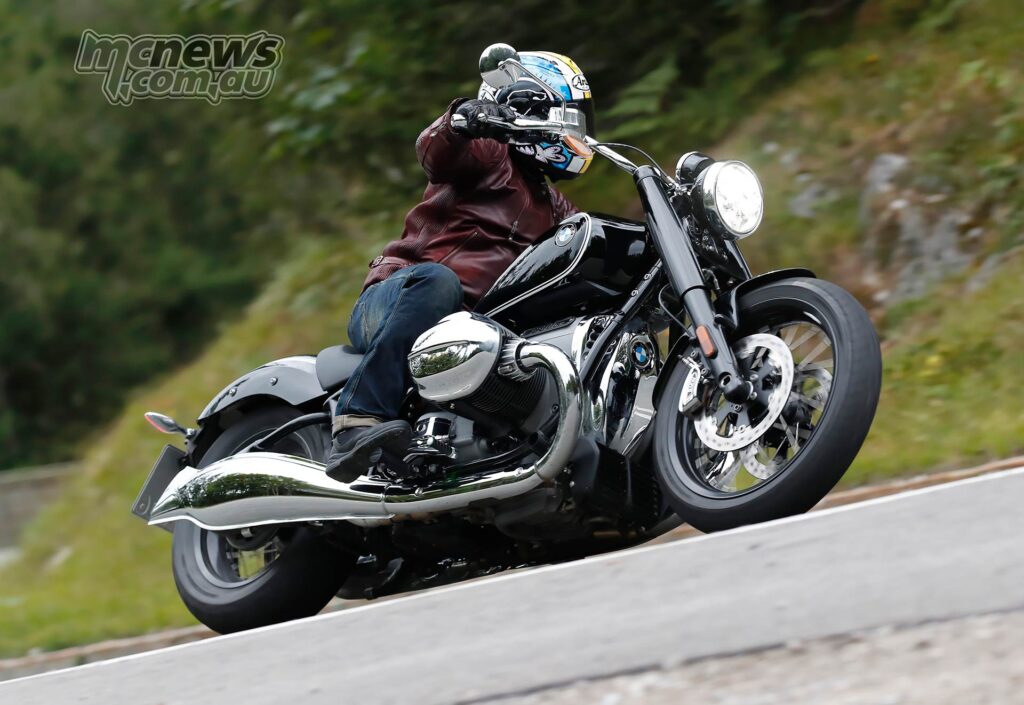
Over longer periods in the saddle, the set-up did feel a bit on the firm side, which I guess is the pay-off for having suspension that doesn’t wallow and force the bike wide when ridden with the faintest bit of aggression.
The riding position is comfortable, the ’bars not too wide, and the vibrations are apparent but not annoying in any way, though I did have numb-bum after a full day in the saddle. Again, I might be reaching for a plusher aftermarket seat in the accessories catalogue before embarking on any serious long-distance touring.
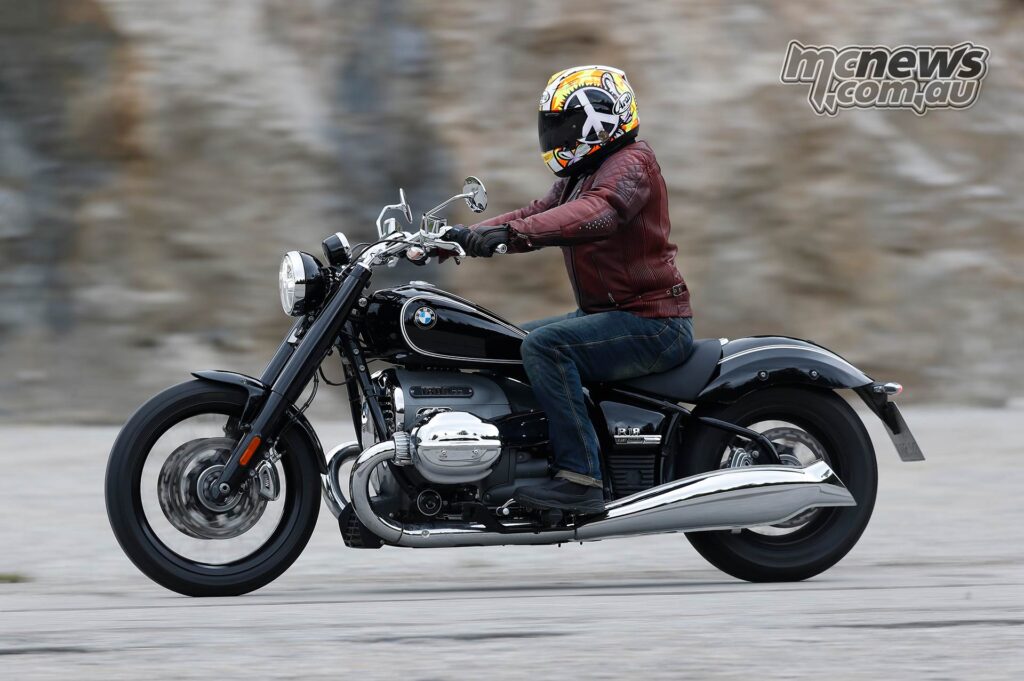
Trying to stop a cow from 160km/h is asking a lot of the twin 300 mm discs and four-piston calipers. The front brake-lever activates the front brake only, but the rear is linked to the front, which gives the sensation of a strong rear brake. Even under heavy use, they didn’t show any sign of fade. The lever is adjustable and there’s a nice feel to it. The ABS comes as standard, isn’t too intrusive on the front, but it’s relatively easy to get the rear ABS activating, especially in the wet.
Unusually for BMW, the ABS is not lean-sensitive, and while you could argue cornering ABS isn’t required on a low revving cruiser, on such a large and heavy bike, it would certainly be welcome. By me, at least. There is nothing wrong with the conventional ABS, but other large, premium BMWs do come with cornering ABS as standard. I guess it all depends on what you are used to.
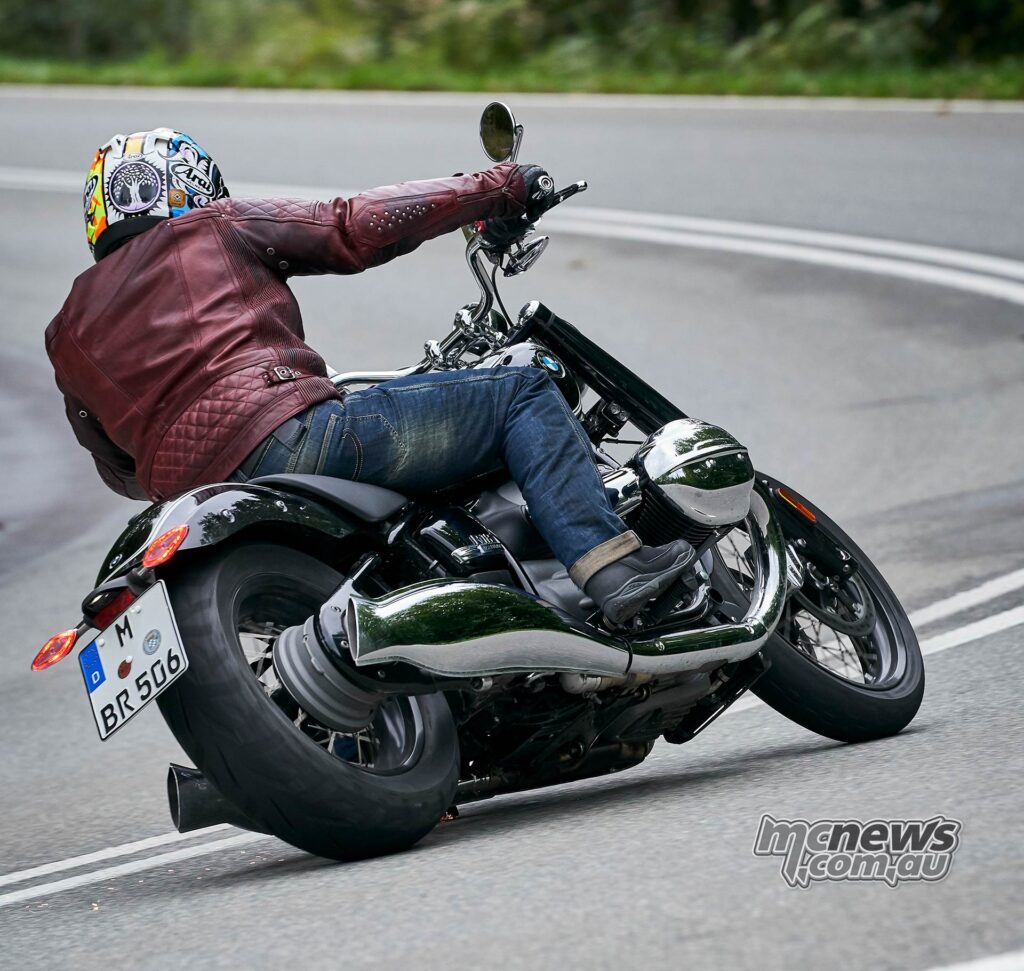
Because there is so much compression from the huge engine, BMW has fitted an engine-braking management system (MSR), which prevents the rear from locking up during fast down-changes. At times you can feel this working, reducing the engine braking, giving it a two-stroke feel as the bike carries speed into corners. Once or twice this caught me out slightly, as the bike rolled into a turn a little quicker than expected without the engine braking. This is certainly favourable to locking up the rear.
A bit over $31,000 AUD Ride Away is a fair swag of money for a single-seat cruiser which doesn’t have cruise control. But given the accessories list is so appetising, few models will leave a BMW showroom in standard trim.
On the other hand, the price is certainly justified in the quality, appeal, and desirability of the new R 18. Not only are you buying into the high-end BMW brand, but this is a completely new and unique model for 2020 – and it’s a lot of bike for your buck.
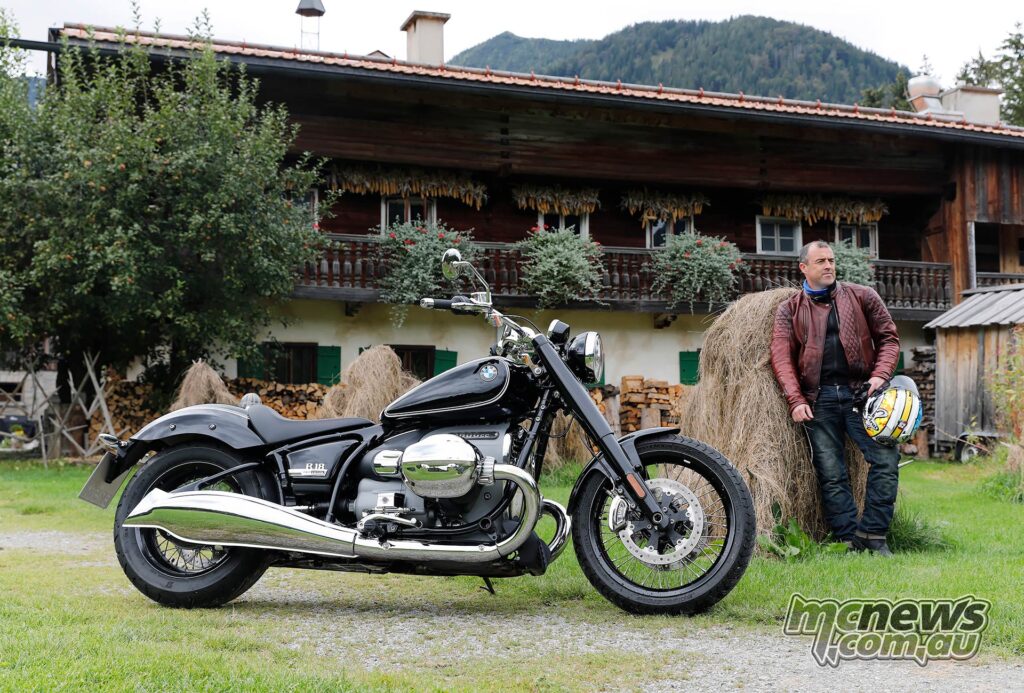
I think it’s priced competitively for today’s market. It’s a hard one to call as you could argue the R 18 doesn’t have any direct competition, but when sports bikes are pushing $50,000 and BMW’s own K 1600 B is more expensive than the R 18, I think its price is in the ballpark.
Rider aids and extra equipment/accessories
Clearly the marketing team named the rider modes Rain, Rock, and Roll, which translate roughly to rain, road, and sporty. The rider aids only change the engine performance and character, and do not alter the standard traction control or ABS. There is a noticeable step in the throttle response and power between the modes. Rain is very soft and lethargic, whereas the Rock mode is responsive and direct, but not too sharp, which is a mistake some manufacturers make. In the wet or when grip is reduced, Rain mode is beneficial and not just a gimmick. With so much power and torque it’s easy to lose traction.
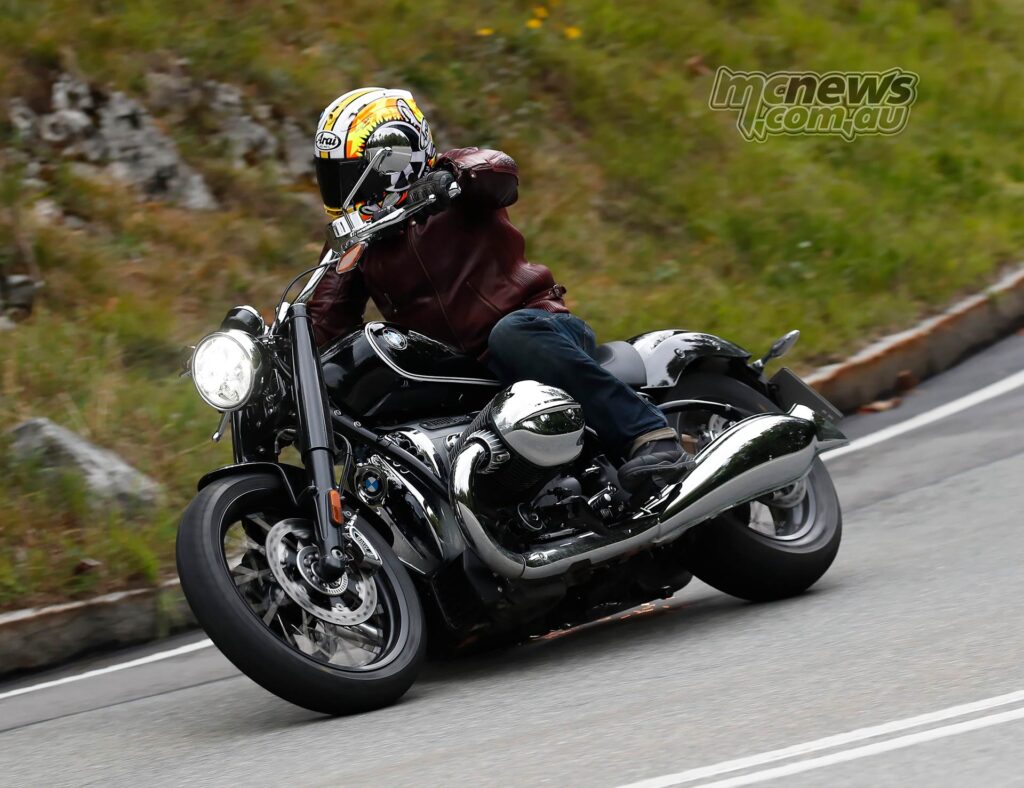
The standard traction control is switchable on the move and will obviously prevent any major slides or wheelspin, but again, like the braking, it isn’t lean-sensitive and is relatively basic. Yes, it works, and the reintroduction of the power is soft, which means once the rear starts to spin, it shouldn’t spin again when the power comes back on-line. However, shouldn’t we expect lean-sensitive traction control from a premium BMW?
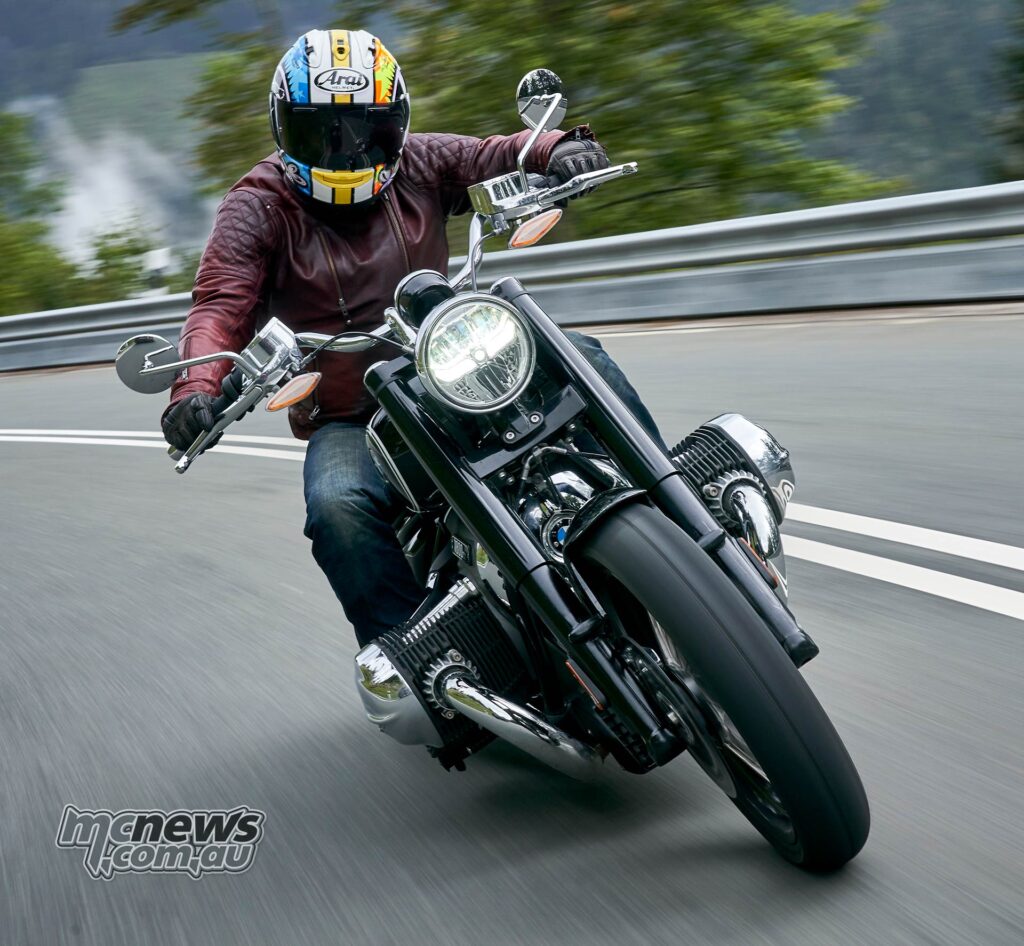
As you’d expect the list of accessories is huge and designed and built in partnership with legendary players like Roland Sands and Vance & Hines. The R 18 is really a blank canvas for your imagination to run wild.
I left my trip to Germany thinking: heel-and-toe lever and foot-boards, V&H pipework, relaxed ’bars, and a pillion seat. The ‘hipster’ clothing matches the high-end finish to the accessories. Some may sneer at the marketing and image, but BMW has cleverly created an altogether stunning bike, which can be easily modified and personalised, and very few models will leave showrooms standard. In my shopping list, I’d also include the heated grips, reverse gear, and hill-start, which are all optional extras.
Verdict
The R 18 is so different from anything else on the market, BMW has to be congratulated on producing a model so close to the original R 5. It has entered the interesting cruiser market with a huge Boxer statement, and on looks alone it is on a winner. It’s a 2020 model dressed for the 1920s and 1930s. It’s elegant, like a metal sculpture, and it doesn’t appear to be a standard production bike, but rather a hand-built custom from bike builders with rolled-up jeans and beards.
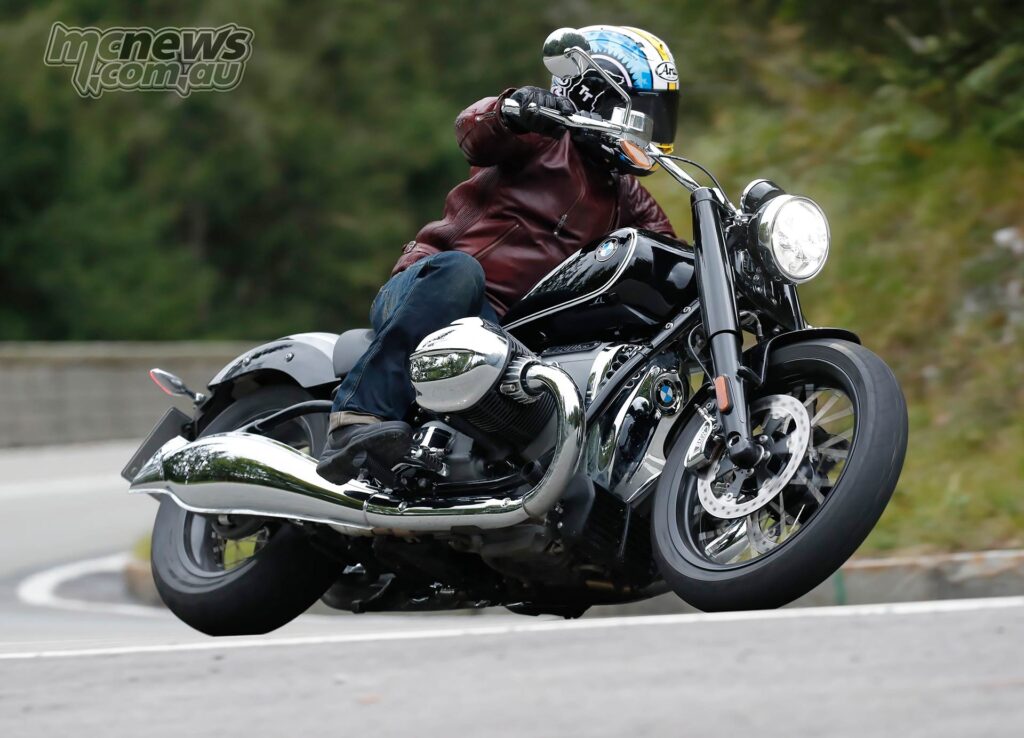
The dramatic Boxer engine holds the design together and delivers some real-world performance, and for a big bike, it will go around corners scraping its pegs all day long. Yes, it’s heavy, yes, it rocks from side to side and vibrates at high revs, but that is what I want… some soul. When you buy a 1802cc Boxer you want it to feel like a big bike.
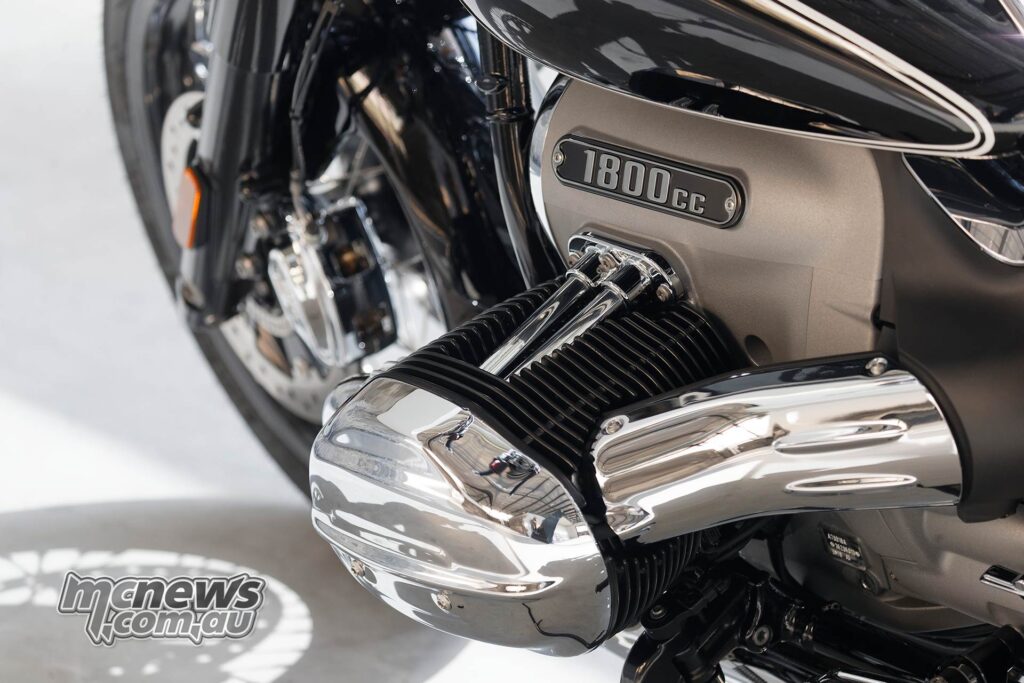
The finishing touches, like the exposed shaft-drive, are lovely, which means I can forgive my personal niggles like the lack of a fuel range/gauge, no keyless fuel cap, and no cruise control.
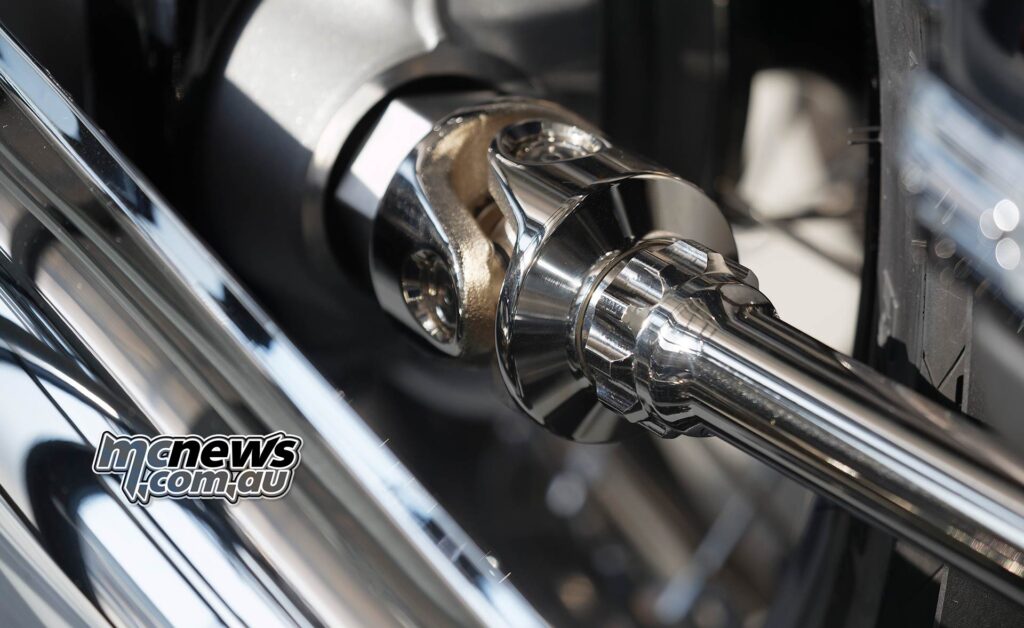
This is BMW’s first venture into the cruiser market for some time and it’s done a remarkable job, which should have the competition worried.
The accessories list is huge and very dramatic, designed in partnership between BMW and Roland Sands, Vance and Hines, and Mustang seats. These include luggage, engine covers, and clothing (as expected), but also Ape bars and a range of larger 21-inch front wheels.
BMW R 18 Specifications
| BMW R 18 Specifications | |
| Engine | |
| Engine | 1802 cc / 110 cui Boxer Twin |
| Bore/stroke | 107.1 mm/100 mm |
| Power | 67 kW/91 hp @ 4,750 rpm |
| Torque | 158 Nm @ 3,000 rpm |
| Type | Air/water-cooled 2-cylinder 4-stroke boxer engine |
| Compression/fuel | 9.6:1 / premium unleaded (95-98 RON) |
| Valve/accelerator actuation | OHV |
| Valves per cylinder | 4 |
| Intake/outlet | 41.2 mm / 35.0 mm |
| Throttle valves | 48 mm |
| Engine control | BMS-O |
| Emissions | Closed-loop 3-way catalytic converter, EU5 exhaust standard |
| Electrical system | |
| Alternator | 600W |
| Battery | 12/26 V/Ah maintenance-free |
| Headlight | LED low beam with projection module LED high beam with projection module |
| Starter | 1.5 kW |
| Transmission | |
| Clutch | Hydraulically activated single-disc dry clutch |
| Gearbox | Constant-mesh 6-speed gearbox |
| Primary ratio | 1.16 |
| I | 2,438 |
| II | 1,696 |
| III | 1,296 |
| IV | 1,065 |
| V | 0,903 |
| VI | 0,784 |
| Drive Type | Shaft |
| Final Drive | 3.091 |
| Suspension | |
| Frame construction type | Double-loop steel tube frame |
| Front wheel control | Telescopic fork, fork tube Ø 49 mm |
| Rear wheel control | Cantilever |
| Total spring travel, front/rear | 120 mm / 90 mm |
| Wheel castor | 150.0 mm |
| Wheelbase | 1,731 mm |
| Steering head angle | 57.3 ° |
| Brakes | |
| front | Twin disc brake Ø 300 mm |
| rear | Single disc brake Ø 300 mm |
| ABS | BMW Motorrad Integral ABS (part-integral) |
| Wheels | |
| Type | Spoked |
| Front Wheel | 3.5 x 19” |
| Rear Wheel | 5.0 x 16” |
| Front Tyres | 120/70 R 19 or B 19 (manufacturer-dependent) |
| Rear Tyres | 180/65 B 16 |
| Dimensions/Weights | |
| Total length | 2,440 mm |
| Total width with mirrors | 964 mm |
| Seat height | 690 mm |
| DIN unladen weight, road ready | 345 kg |
| Permitted total weight | 560 kg |
| Fuel tank capacity | 16 L |
| Performance | |
| Fuel consumption (WMTC) | 5.6 l/100 km |
| 0‒100 km/h | 4.8 s |
| Top speed | 180 km/h |
| MLP | From $26,890 +ORC |










